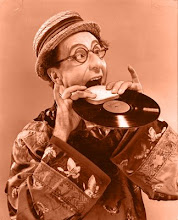BLON-DIEEE-EE-E!!!!!!!!!
 I finally finished watching all 28 of the Columbia Blondie features last night and, after scooping my brain from the floor with a dustpan, I have to admit to some mixed feelings. Columbia's venerable cash-cow has many, many standout moments and even a few entries that I consider B-comedy masterpieces, but the low-points of the series are pretty appalling, even for disposable Columbia product. Columbia's tendency to wring every last drop from a property is on full display here. While Chic Young's comic strip made a game of stock situations and formulas, Columbia rather inevitably turned that game into a scheme to cut corners. By the end, tossed to former sound man and shorts director Ed Bernds, the Blondie films were being handled as carelessly as any late-era Three Stooges short.
I finally finished watching all 28 of the Columbia Blondie features last night and, after scooping my brain from the floor with a dustpan, I have to admit to some mixed feelings. Columbia's venerable cash-cow has many, many standout moments and even a few entries that I consider B-comedy masterpieces, but the low-points of the series are pretty appalling, even for disposable Columbia product. Columbia's tendency to wring every last drop from a property is on full display here. While Chic Young's comic strip made a game of stock situations and formulas, Columbia rather inevitably turned that game into a scheme to cut corners. By the end, tossed to former sound man and shorts director Ed Bernds, the Blondie films were being handled as carelessly as any late-era Three Stooges short.First, let me say that I'm a big fan of Chic Young's original strip which was at its creative peak when Columbia purchased the screen rights in 1937. Only four years prior, Young had converted his run-of-the-mill flapper strip into a mini-saga about lower middle-class family life and was soon running in over 250 papers, making it one of the most widely read strips in the nation. Despite whatever overtones of Americana the strip has picked up over the decades, Blondie was a far from idealized portrait of American life, with the flighty and hapless couple forever besieged by bottom-feeding vultures ready to strip them of what little cash and dignity they had. Even the Bumstead's friends and neighbors always
Be that as it may, the series has some pretty unique qualities. While it can claim a certain fidelity to the strip, more importance is placed on the series' fidelity to itself. The key sets, the Bumstead home and the offices of the Dithers/Radcliffe Construction Company, remained the same for 12 years giving the movies, in that regard at least, a heightened sense of realism. Similarly, a decision was made to allow actors to "own" their roles, thus, when Jonathan Hale left in 1946, his character of J. C. Dithers was replaced rather than recast and an entire story written to introduce Jerome Cowan as Dagwood's new boss, Mr. Radcliffe. Likewise for Danny Mummert who played Alexander Bumstead's best friend Alvin Fuddle from the beginning in 1938. When Mummert was unavailable in 1945 due to his appearance in It's a Wonderful Life (along with Larry "Alexander Bumstead" Simms), his role as the sarcastic neighbor kid was taken by Bobby Larson as egghead Tommy Cooper. Stock motifs brought over from the strip, such as Dagwood bowling over the mailman while rushing to catch his bus, are shot nearly identically for each film allowing for some fun variations when Blondie or Alexander repeat the pattern. Less fun is the increasing dependency on stock formulas in the plotlines. By 1945, virtually every Blondie film ends in precisely the same way, with Blondie using some incredibly unlikely advantage to force Dithers or Radcliffe to give Dagwood his job back with a raise and a bonus (both have inevitably vanished by the next picture). Even the loose rules of farce comedy are stretched to the limit by the collections of brain-bendingly impossible coincidences that constitute the stories for such entries as Leave It to Blondie (1945). The bottom falls out the franchise soon after Ed Bernds takes over the director's chair from Abby Berlin in 1948. Cheap slapstick replaces character comedy and it suddenly seems as though no character can leave a room without knocking his or her head against the door. The final two Blondie films, both 1950, s
Ignoble end aside, the series' highlights are plentiful, chief among
Labels: Arthur Lake, cinema, comic strips, Hans Conried, Jerome Cowan, Jonathan Hale, Penny Singleton








6 Comments:
Nice write-up on the venerable series, but Jonathan Hale played Dithers in the early films...not Gale Gordon.
Gale/Hale.. Jeez. You can just sense the strain that goes into this, can't you? I had Mr. Wilson on the brain because I'm working on another post..
Anyone know why Hale killed himself in 1966?
People kept confusing him with other performers....?
Fascinating -- where did you get ahold of all 28 Blondies, anyway?
Ebay. The picture quality is just barely passable as four to five films are crammed onto each single-sided DVD. For the price, though, I can't complain.
she has tons of imformation on these web sites
Post a Comment
<< Home